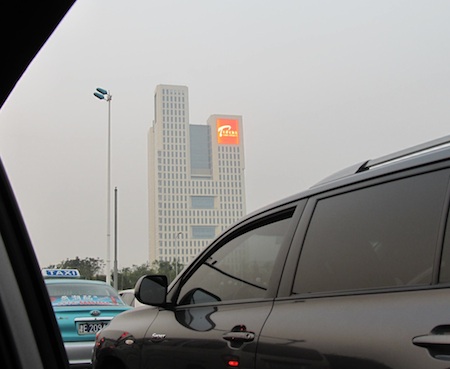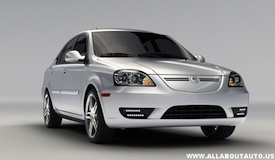
TIANJIN, China – Whatever the differences that irked delegates from China and the United States during the six days of climate negotiations that ended here on Saturday, divisions principally defined by how each would control carbon emissions and measure progress, the unmistakable conclusion reached by most of the delegates and participants is how closely tied the two nations are to each the other.
Lying quietly below the nuanced diplomatic language of frustration and distrust expressed all week by Chinese and American negotiators is an expanse of cooperative projects in and outside government that are expressly designed to help China and the U.S. use energy more efficiently, develop new technology, and lower carbon emissions.
Participants this week toured an advanced coal-fired power plant that is being built by a consortium of Chinese companies and includes an American coal company. Chinese and American partnerships also are being forged in solar and wind manufacturing, and in carbon capture and sequestration emissions control technology. The two countries last year established a joint clean energy research center, with offices in China and the United States.
Coda Electric Car
Another good example is how Coda Automotive, a California-based electric vehicle manufacturer, and Lishen Battery Company, a Tianjin-based manufacturer, are collaborating to build batteries in their joint venture factory for Coda’s all-electric cars for sale in the U.S. starting early next year. The powerful, 800-pound lithium-ion battery pack that will provide the Coda with a 100-mile range between charges, is being built and assembled in Lishen’s joint venture plant on the city’s south side.
The Coda’s drive train and electric engine are American designs built in factories in the U.S. The car’s safety systems were engineered by American and European experts and will be built by American companies. And a Chinese auto manufacturer will receive all of the various parts and assemble them under contract into new cars for shipment to the U.S. The company is planning to build a battery assembly plant in Ohio, where Coda’s chief executive, Kevin Czinger, was raised.
In his blog posts and various interviews in recent months Czinger has expressed his own frustration with energy and climate policy in the U.S. But that is not affecting his company, which he says will sell 14,000 cars in California next year. “The good news is that we can take action,” Czinger writes in his latest blog post. “We don’t need to wait for our leaders. Â We can do what we do best – Â take new ideas and new technology and create. Â The electric car can be the driver of a new economic and energy system. Â It can be the driver of a new American mindset and a revived manufacturing foundation. Â Within a globally interdependent world that will have increasingly higher shipping costs, we can rebuild our car industry based on a new technology. Â And we can replace our foreign oil with clean, secure and affordable electricity generated in America. Â We can create a new prosperity for this century. Â We have the choice. Now.”
The Coda (see pix right) will be priced at around $45,000, and with federal and state electric vehicle and clean energy incentives, the off-the-lot cost will be closer to the low $30,000’s. Either way, neither the Coda, nor the other all-electric passenger cars making their way to the market – the Nissan Leaf and the Ford Focus – are priced low enough for sale in the world’s largest car market here in China.
Biggest Car Market and Big Oil Demand
Last year, China surpassed the U.S. as the world’s number one vehicle market, recording 13.5 million car and truck sales, according to the China Passenger Car Association. Manufacturers, by contrast, sold 10.43 million in the U.S., according to the Center for Automotive Research at the University of Michigan. This year vehicle sales in the U.S. could reach 11.6 million according to J.D. Power.
Sales in China in 2010 are expected to top 16 million units. Xu Changming, a research director at the State Information Center, told reporters in June that the number of vehicles in China could reach 78 million units, up from 63 million at the end of 2009, and surpassing Japan as the second largest nation for vehicle registrations. He also said the number of vehicles in China is expected to eventually rise to about 490 million units, though he did not offer a date for reaching that forecast.
A Coda executive on Saturday said that at the current sales pace China’s vehicle population could reach 200 million by the end of the decade, or roughly 60 million less than the number of vehicles in the U.S. this year.
Electric vehicles, of course, are a staple of transportation in China, though most of them are two- and three-wheel bikes, scooters, and carts fitted with small electric motors. The country manufactures state-of-the-art electric buses, a number of which were used to quietly transport climate negotiators and participants to and from the conference center and their hotels.
The country also is rapidly electrifying its high-speed rail network capable of transporting tens of thousands of passengers on trains, like the one that links Tianjin to Beijing (see pix below and right), capable of speeds in excess of 200 miles per hour. According to Chinese NGO experts at the climate conference, China has built 4,000 miles of high speed rail and is in the process of constructing 6,000 more miles.
China, though, could use many more electric cars. Gas and diesel-fueled cars jam China’s highways and urban streets, and contribute to the smog in China’s major cities that is so thick (see pix above in Tianjin) it obscures the tops of buildings. The rapid rise in vehicle ownership also is challenging China’s economic security, just as it is in the United States. China’s oil consumption last year reached 8.625 million barrels a day, or 3.1 billion barrels annually, or nearly twice China’s consumption in 1999, according to the respected 2010 BP Statistical Review of World Energy. U.S. oil consumption is now just under 7 billion barrels annually, according to the Department of Energy.
China produces nearly 3.8 million barrels of oil daily from its own oil fields, which means that it imports 56 percent of its petroleum. That percentage will grow steadily higher. The demand for oil in China grew 539,000 barrels a day from 2008 to 2009, or nearly 7 percent. Meanwhile China’s oil production fell 111,000 barrels a day during the same period, or just under 3 percent.
— Keith Schneider



Thanks for finally talking about > Talk of Tianjin Climate Conference: China and U.S.
Are Electrifying The Car | ModeShift < Liked it!